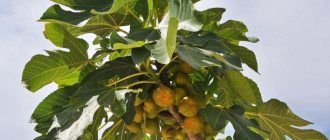The best way is to plant deep in trenches.
They need to be dug in such a way that the depth is at least half a meter and the width is about a meter. If the soil is loamy, it is better to pour a drainage layer of sand and fine gravel onto the bottom.
For the substrate, surface soil is mixed with humus, manure and compost, and then poured into the planting hole.
After this, small mounds are poured onto which the seedlings will be placed. To do this, the roots are straightened, and the seedlings are covered with earth, holding the stems to the level of the root collar.
For the substrate, surface soil is mixed with humus, manure and compost, and then poured into the planting hole.
The southern slope is covered with a dense black film, which will not only protect the root part of the stem, but also prevent weeds from growing. The appearance of weeds can lead to diseases, as they block the bottom of the bush from the sun.
From the northern part you need to install a polymer wall or from slate sheets. It will reflect light rays and smooth out uneven lighting.
Bush formation
To properly form a plant, you need to understand how figs grow.
To create a compact shape, you need to build a trellis from wooden slats or ordinary wire. A bush will be tied to it.
In the first year of development, when pruning, three upper shoots 20 cm high are left. One of them is launched vertically, and two lateral ones are tied to a trellis. The result is a kind of trident.
When the stems reach a height of about a meter, they are bent parallel to the ground. Further growth of the stems is started vertically and tied to ensure precise angles.
Next spring, the trunk, which is located in the middle of the bush, is cut 20 cm above the point where the branches appear. Then we repeat last year’s procedure.
To properly form a plant, you need to understand how figs grow.
In this way, the plant needs to be grown to 4 tiers of branches. At the last stage, only two branches are left, which run in different directions parallel to the ground. When they grow 10 cm, they are allowed to grow vertically.
As a result, you get a neat, compact bush that can become a decorative element of the landscape. For example, near garden paths.
Culinary recipes based on figs
In addition to its medicinal properties, figs have an unusual honey taste, thanks to which they are used to prepare many culinary delights. Below you can find out how to prepare the most delicious dishes and drinks based on it.
Fig jam
Fig jam is not only tasty, but also healthy, and can be prepared in just 40 minutes.
Jam ingredients:
- Granulated sugar – 0.5 kilograms.
- Fresh figs – 700 grams.
Cooking method:
Take ripe figs, wash them and cut off the ends. Place the fruits in a saucepan and cover them with sugar. Leave the mixture for three hours until the juice appears.
Place the pan with the fruits on low heat, bring to a boil and skim off the foam. Boil the figs for 5 minutes, stirring occasionally to dissolve the sugar. After this, the jam should be removed from the stove and left to steep for 10 hours.
After the time has passed, you need to boil the jam again over low heat, collect the foam and boil for 5 minutes. Then the pan must be removed from the heat again and the jam left for 10 hours. This procedure should be repeated again, after which the jam should be poured into sterilized jars and rolled up.
Cake with figs
This easy-to-make fig and mascarpone cake will be a great decoration for any occasion.
Filling ingredients:
- Yogurt – 600 grams.
- Granulated sugar – 100 grams.
- Mascarpone – 300 grams.
- Gelatin – 20 grams.
Cake components:
- Muesli baked with nuts – 400 grams.
- Butter – 120 grams.
Decoration:
- Lemon juice – 0.5 lemon.
- Fresh figs – 20 pieces.
- Sugar – 50 grams.
- Raspberries – 120 grams.
Preparing the cake:
Take a springform pan with a diameter of 24 centimeters, put cling film on the bottom, and cover the sides with parchment. Preparing the crust. To do this, melt the butter and grind the muesli in a blender. Then we combine these two ingredients and put them in the mold and level them, compacting them in parallel with a spoon. Place the finished cake in the refrigerator for half an hour.
Take gelatin and soak it in water for 10 minutes. Place the finished mixture in a saucepan and heat it over low heat until dissolved. Remove from heat and strain into a container with yogurt. Add cottage cheese and mascarpone, and then beat. Pour the resulting filling onto the crust, level it and put it in the refrigerator for 4 hours.
Take raspberries and sugar, mix and put in a saucepan. Place on the stove and bring to a boil, then boil for 3 minutes and cool. When the mixture has cooled, mix it with lemon juice and grind with a blender. We rub the resulting sauce through a sieve.
After 4 hours, remove the cake from the refrigerator, remove it from the mold and decorate with chopped figs and raspberry sauce.
Reproduction
Figs, the care and cultivation of which require care, are also demanding in terms of propagation methods. It is believed that the optimal ways to transplant a plant in our climate are:
- propagation using cuttings;
- seed method.
Propagation using cuttings Seed method
Which variety is better to choose for home growing?
Growing figs at home is not difficult, but to do this you need to carefully choose the variety; it is better to choose a group of low-growing varieties with self-fertile seed development that do not require pollination.
Among beginners and experienced gardeners, the Sochi and Solnechny, Violet Sukhumi and Kadota figs are especially popular; their sizes are quite compact, tolerate minor temperature changes and bear fruit well throughout the life of the plant.
Propagation by cuttings
For this method, you can use both winter seedlings and summer green shoots.
Winter cuttings are taken only from plants that are at least a year old. Cuttings are planted in early spring in light soil until buds appear.
Green cuttings should be planted in late spring or early summer, preferably in sand. Cuttings are taken from fruit-bearing plants. Before rooting, they are kept in a humid environment. (This can be a jar of water or a regular glass).
Cuttings are planted in early spring in light soil until buds appear.
Place the container in a warm place. After about 3-4 weeks, roots will appear, and when they are 1-2 cm long, they can be planted in the soil.
Water requirements for irrigation
Suitable water for irrigation is soft, without chlorine and lime, previously standing in the sun. Its temperature should be at least +20°C. Experienced gardeners recommend using melt or rain water.
Simple drain structures are installed on the site, through which moisture enters empty plastic or iron barrels. Rain and melt water is enriched with natural oxygen, making figs less likely to get sick.
If the summer is dry and there is no rainwater, use tap water. The disadvantage is that it contains chlorine and lime and is hard. To soften the water, gardeners add 2 drops of lemon juice to 10 liters. Apple cider vinegar is also used to soften - 10 drops dissolved in 1 liter of water.
Attention! Do not water figs with water from open bodies of water - swamps, rivers or lakes. It may contain dangerous fungi and pathogens that cause tree diseases. Due to such watering, figs will develop coral spot, anthracnose or gray rot.
What can I add?
To ensure that watering brings double benefits, once a month gardeners use not plain water, but an infusion of herbs: chamomile, calendula, nettle, burdock, tansy, sage.
The procedure increases the number of ovaries on the tree and prevents the appearance of insect pests: whiteflies, greenhouse thrips, earwigs, nematodes, spider mites. Moisten the figs early in the morning, before sunrise.
To increase yield, figs are watered with banana peel infusion. It is filled with water and left for 3-4 days, after which it is applied under the tree into specially prepared holes 8 cm deep. Such watering is aimed not only at moistening, but also at feeding the tree and replacing organic fertilizers.
Seed method of propagation of figs
To obtain the starting material, only the best juicy fruits are selected. The pulp with seeds is selected from them, placed in a bowl and left in a warm place for about 3-5 days. After the mass begins to ferment, the seeds are separated from the remaining pulp, washed and dried. After which they are stored until February, when they begin planting.
Then the starting material is sown into a prepared substrate consisting of humus, turf soil and sand, to a depth of about 0.5 cm. The appearance of the first shoots is expected in about a month, provided that the soil is sprayed daily with warm water. After 6-8 leaves appear, the seedlings are planted in separate pots with a diameter of 10 cm.
To obtain the starting material, only the best juicy fruits are selected.
The plant will be ready for transplanting into open ground in 2 years. During the period of growing seedlings at home, they need to be fertilized, and with the onset of stable heat they are taken out into the open air. They can stay there until autumn.
Popular varieties of figs
Experienced gardeners recommend choosing self-fertile varieties that do not require pollination. The most popular of them:
- “July early” - bears fruit twice per season, defenseless against cold weather;
- "Dalmatian" is the most frost-resistant. Fruits with a gray-green skin and a pleasant sweet and sour taste;
- 'Kadota' produces oval-shaped fruits with a sweet taste.
Preparing for winter
After the end of the growing season at average temperatures of about 2 degrees Celsius, you can begin to cover the bushes. To do this you need:
- Remove autumn structures: arcs, non-woven material and polycarbonate.
- Bend the branches to the ground.
- Lay boards or sheets of plywood on top of the pit.
- Lay a durable film over the flooring.
- A layer of earth of about 10 cm is poured over the entire structure. It will prevent frost from penetrating the tree.
In particularly frosty regions, you can add an additional layer of insulation.
The presence of air in the shelter will ensure normal aeration of the plant.
In particularly frosty regions, you can add an additional layer of insulation. The following can act as natural insulation:
- straw;
- corn tops;
- spruce branches
The following can be used as cargo placed on polyethylene:
- boards;
- cardboard;
- roofing felt
If the covering material is too dense, small holes are made in it to allow air to enter.
Wintering figs in open ground
Figs overwinter in shelter. Although winter-hardy varieties have been bred, it is not worth taking unnecessary risks. The plant may freeze and die.
Sheltering figs for the winter
The shelter is made like this:
- Water the bush so that the branches are flexible. Bend several branches to the ground and fix them. After 4-5 days, do the same with several more branches. So, in 3-4 steps, all the shoots will be bent.
- When frost sets in and the plant loses its leaves, the branches are wrapped with breathable covering material: burlap, agrofibre.
- Bent and wrapped branches are fixed. In winter they throw snow on them.
Important! You cannot cover figs with polyethylene - fungal diseases will begin.
If the fig is in the shape of a tree, then a mini greenhouse is built above it. The tree trunk circle is mulched with a thick layer of sawdust and humus. A frame is installed above the tree and sheathed with polyethylene.
With the first warmth, the plants open.
Spring care
After the end of the cold weather, one of the most important moments in caring for figs is the timely opening of the plant.
To prevent the stem from drying out, it must be opened in mid-April. If the soil above the structure has not thawed, it can be spilled with hot water.
To prevent the stem from drying out, it must be opened in mid-April.
After this, a greenhouse is erected over the tree, and the associated branches are straightened. The stem is cleared of dry leaves, while the fruits formed during wintering are left on the branches.
Medicinal properties of figs
In folk medicine, fig fruits and leaves have been used since ancient times. Products made on their basis allow you to fight the following ailments:
- Bronchitis and pneumonia;
- Thrombosis and thrombophlebitis;
- Sore throat and laryngitis;
- Constipation;
- Depression;
- Inflammatory diseases of the genitourinary system;
- Hypertension and anemia.
Effective wound-healing ointments are prepared from dried fig fruits. Decoctions of the leaves are used for eczema and furunculosis. The phytotherapeutic drug "Psoberan" is prescribed for the treatment of vitiligo and psoriasis.
Figs with cough milk recipe
As mentioned above, figs can help you cope with many diseases, including coughs, for which there is one effective remedy based on this sweet fruit.
To prepare a medicinal drink, you should boil half a liter of milk over low heat. When it boils, you need to put 5 dry figs in it, after which the resulting mixture should be boiled for about half an hour. Then you need to remove the pan from the heat, wrap it in a towel and leave to steep for 4 hours.
Milk and figs should be consumed separately. Fruits should be eaten three times a day before meals, and milk should be heated and drunk before going to bed. Milk-fig therapy is carried out throughout the week.
Diseases and pests
Based on where figs grow, you need to be prepared for the fact that the plant will be susceptible to various diseases and be attacked by pests.
The most common diseases are the following:
- Branch cancer, which covers the affected area of the trunk with cracks. As a result of the disease, the wood is exposed and part of it dies.
- Gray rot manifests itself as a gray and white coating on the fruits themselves.
- Fusarium leads to internal rotting of the fruit and peeling of the pulp.
- Anthracnose is characterized by the appearance of dark spots on fruits, which lead to rotting of the fruit.
- Fruit souring begins with the appearance of various brown or watery spots.
Branch cancer Gray rot Fusarium Anthracnose Fruit souring
Home care
Indoor figs, despite their unpretentiousness, need care and attention. It can please its owner with bright, beautiful leaves and tasty fruits only under comfortable conditions of its existence.
Location and lighting
The best location for a subtropical beauty will be a window sill on the eastern side of the room. Figs love diffused light and can hardly tolerate the burning sun, so the eastern direction is the best option. In this case, there is no need to shade the crop.
If it is not possible to place the pot on the east window, you can place it near the southeast or south window. The window needs to be curtained with a light curtain.
Daylight hours for an exotic crop during the growing season should be at least 13 hours . The plant does not need artificial lighting; in the summer, natural light is enough for it.
Temperature
Figs are a heat-loving plant. The optimal temperature for active development is +22°C +26°C . It is advisable to maintain these parameters from March to mid-October. The tree loves fresh air. In summer it will feel great outside, but away from the scorching sun.
You can keep the plant outdoors all summer long, if there are no large differences between night and day temperatures. In autumn and winter, when the figs are resting, you need to maintain the temperature within +8°C +12°C .
Air humidity
"Carian ficus" needs high humidity. This parameter should be in the range of 70-80% . Dry, overheated air is harmful to residents of the subtropics. The plant will begin to wither and lose leaves. To maintain a high level of humidity, you can place a household humidifier next to the pot. Large containers filled with water, which will evaporate gradually, are also suitable.
In summer, it is necessary to spray the tree with a spray bottle every day. You need to spray both the leaves and the trunk. Do not wipe the foliage with wet wipes or other materials. Fig leaves are rough and covered with tiny fibers. They do not tolerate mechanical stress.
A warm shower once a week is very useful . It will help the “green pet” in the fight against overheating, and at the same time will serve as an excellent preventive measure against spider mites. In the autumn-winter period, the spraying procedure is not carried out. In winter, figs shed their leaves and do not need additional moisture.
Soil composition
Figs are not picky about the composition of the soil. The only thing that can harm it is acidic soil with a high peat content. Therefore, when purchasing a ready-made soil mixture in a store, you need to be interested in the level of acidity and percentage of peat. The plant needs light, loose soil with good breathability.
You can purchase optimized soil for palm trees and ficus trees, but experienced plant growers advise preparing the soil yourself. To do this take:
- Leaf humus.
- Coarse river sand.
- Wood ash.
- Sod land.
The ingredients are mixed in proportions - 2:1:1:2.
Additionally, finely crushed eggshells . This will make it looser and improve the structure. River pebbles, small crushed stone, and pieces of ceramics are suitable for drainage. Soil made with your own hands must be disinfected. You can bake it in the oven at +90°C or pour it with a solution of potassium permanganate.
Proper watering
Figs growing indoors require abundant and regular watering. In warm weather, the fruit crop is watered once every 2 days , using settled water at room temperature.
The soil must always be moist . Severe drying out of the soil can cause foliage to fall (at best), and at worst lead to the death of root hairs. In this case, the tree will die. At the same time, you cannot plant “swamp” in a pot. Excessive moisture leads to rotting of the root system.
In hot weather, combine watering with daily spraying of the plant. It is necessary to loosen the soil in the pot at least once every 7 days to remove the earthen crust formed after watering. This procedure improves air exchange and allows the roots to receive more oxygen.
Top dressing
Figs need fertilizing during the active growing season and during fruit formation. The first fertilizing is applied in mid-winter , as soon as the plant comes out of the dormant phase. Nitrogen-containing fertilizer is applied to stimulate leaf growth. Further, until October, fertilizing is carried out once every 14 days , using both organic matter and mineral complexes.
Fruit crops love organic fertilizers. You can feed the tree with a mullein solution (1:10) or wood ash (1 tsp per 1 liter of water).
When it comes to mineral supplements for figs, complex formulations for citrus crops are well suited. Fertilizers must be applied only after watering the plant and strictly in the dosage specified by the manufacturer. Excessive amounts of minerals in the soil can destroy the plant.
Rest period
"Carian ficus" has a clearly defined dormant period. It usually begins at the end of autumn . During this period, the plant sheds its leaves and prepares for winter rest.
The pot should be moved to a cool and shaded room. The temperature during the rest period should be maintained at +8°C +12°C . During this period (November - January), fertilizing is stopped and watering is minimized.
Water the plant rarely, only so that the earthen ball does not dry out. Use cool water for irrigation so as not to awaken the buds.
Flowering and fruiting
Fig flowering has its own characteristics. Flowers, as such, do not appear on it. During the flowering period, hollow berries, pear-shaped or round, form on the branches. Inside these berries, which are inflorescences, there are small, inconspicuous flowers. To see these flowers, the inflorescence must be broken.
Inflorescences appear early and can sometimes be seen in February. In this case, the harvest of homemade figs can be harvested in June. An adult, healthy tree can bear fruit 2 times a year , in summer and autumn. The first fruiting can be observed 1 year after planting. In some cases, the deadlines are shifted by 6 months in one direction or another. This depends on the variety and age of the purchased specimen.
Trimming
Fig pruning is an important maintenance consideration. It promotes the full development of fruit crops. Figs grow quickly and without formative pruning they will stretch upward, becoming like a palm tree. This will negatively affect its appearance and the abundance of fruiting. Pruning is carried out in January, before the tree leaves the dormant phase. In young specimens that have reached a height of 30-40 cm , pinch the top and cut off the side branches to ⅓ of the length .
This is necessary to stimulate the growth of strong, strong second-order branches. When pruning, the upper buds should be directed to the sides of the crown, and not to the center. Regular, proper pruning will help to form a spectacular lush bush and give the plant a neat, compact appearance. During the first 4-5 years of life, figs need to be replanted every year. In the future – once every 3 years .
Transfer
The plant is replanted when it comes out of the dormant phase, when the buds begin to swell. The pot is chosen to be deep, but not too spacious. In a wide container, figs will begin to actively grow roots to the detriment of the development of the above-ground part.
For replanting, choose a pot that is only 5-6 cm larger than the previous one. 3-5 cm layer of drainage is placed at the bottom of the new container , and fresh soil is added. Carefully, without destroying the earthen lump, remove the plant from the old pot and transfer it to a new container. After transplanting, the fig tree needs to be watered and placed in a bright place.
Pests
The following pests can attack the bush:
- A moth that can cause fruit to rot.
- The leaf roller, which is considered a pest of honeysuckle, damages the bush in such a way that the leaves turn yellow, the fruits begin to rot, and the stem itself dries out.
- The psyllid threatens to slow down the growth of the stem due to the lack of nutrients sucked out by the pest.
- The pine beetle damages the bark, which often leads to the death of the plant.
Moth moth can cause fruit to rot
To control pests, it is necessary to use special insecticides, and various fungal diseases can be overcome by normalizing the climatic watering regime and careful care.
Advice from experienced gardeners
Watering of figs begins at the end of May. Previously, this is not done, because there are still reserves of rain and melt water in the soil.
In addition to this rule, experienced gardeners share other useful recommendations:
- After each watering, the soil is loosened. The procedure serves to prevent diseases and insect pests, increases the moisture capacity of the soil and prevents the development of weeds.
- Summer residents use sprinkling only if the weather is hot. If the climate is damp and humid, the procedure is not used.
- Water the figs with melt, rain or tap water. Suitable temperature is about +20°C.
- During fruiting and 10 days before it, the plant is not watered.
This is interesting:
Simple ways to propagate figs from cuttings at home
Step-by-step instructions on how to properly cover figs for the winter and prepare the tree for cold weather
Harvesting
With proper planting and care of figs, growing them in open ground can bring a good harvest. Fig fruits ripen extremely unevenly, so they are removed from the trees as they ripen. A sign of ripeness is the appearance of drops of nectar on the skin, the color of the fruit depending on the variety, as well as the softness of the fruit. When the fruit is torn off at the point of separation from the branch, no juice is released.
Fresh figs can be stored for about 2-3 weeks. During this time it must be processed. It is usually used for making jam and as fillings. And when dried it becomes one of the popular dried fruits.
Having understood the intricacies of growing shrubs in open ground and the peculiarities of caring for them, you can get a stable harvest of tasty and healthy berries.
Figs in autumn and winter
The fruits of figs ripen in autumn. As soon as the night temperature drops to 2-3 ⁰C, you need to bend the fig branches to the ground, fix them in this position, install metal arcs over them and stretch agrofibre, oilcloth or other covering material over them. In such conditions, figs will survive the winter without problems.
In early spring, fig branches are lifted, but it will be possible to remove agrofibre from the arches only after the spring return frosts have ended - at the end of April or at the beginning of May. However, it is necessary to constantly monitor the condition of the covering material and promptly repair gaps.
Why figs don't bear fruit
- There is little light - place it on the brightest windowsill or transplant it to an open sunny place in the garden.
- Too much space for roots - transplant into a cramped pot or limit the space in the planting hole.
- The crown froze in winter - it takes up to 3 months to recover.
- Not enough water and nutrition - water generously and feed regularly.
- Pest damage - spray with Epin solution or an analogue 2 times.
- Dense crown - trim off unnecessary branches. Figs produce the best yields when grown in 2 stems with regular pinching of the ends.
So, caring for figs is not at all difficult, and you can enjoy the harvest of exotic plants in any climate.
It is also easy to grow currants on a trunk at a summer cottage.
Did you like the article?
Support our project by reposting on social networks! Share:
Growing figs at home: what is important for a gardener to know
The fig tree takes root well, this condition applies to the southern regions, with the warmest climate possible, but it is important to remember that in greenhouse conditions the fig tree will actively develop, but with obligatory ventilation and abundant watering.
The reason why figs drop their fruits may be a lack of nutrients and elements in the soil, the onset of sharp frosts or a gradual decrease in temperature, or planting the plant in a cold draft or in a shaded area.











